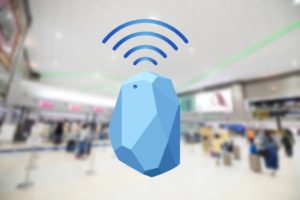Beacons have been causing a stir since Apple introduced its iBeacon technology in 2013. Back then, this new way of connecting with customers might not have been top of the agenda, but today, all kinds of industries are taking advantage of the potential beacons can offer. Beacons are impacting the lives of people and businesses everywhere; you’ll find beacons broadcasting in stadiums, universities, train stations, popular retail locations, and office buildings, helping visitors and employees to navigate their surroundings and enhancing the overall occupant experience.
Powered by Bluetooth technology, beacons are small devices that are strategically placed throughout a location that can connect with Bluetooth mobile devices in that area. These building-wide beacon networks can enable indoor positioning and location-based services, like wayfinding, asset management, and point-of-interest solutions.
 What’s more is that beacons are ideal for sharing information with visitors, and even locating and tracking valuable items of equipment. They are a perfect fit for museums and stadiums which rely on providing visitors with personalised and fulfilling experiences. For example, when recently swapping existing halogen lighting with Bluetooth enabled LED modules, the Van Gogh Museum in Amsterdam also installed Bluetooth beacons capable of feeding visitors point-of-interest information based on where they are, and what piece of art they’re viewing.
What’s more is that beacons are ideal for sharing information with visitors, and even locating and tracking valuable items of equipment. They are a perfect fit for museums and stadiums which rely on providing visitors with personalised and fulfilling experiences. For example, when recently swapping existing halogen lighting with Bluetooth enabled LED modules, the Van Gogh Museum in Amsterdam also installed Bluetooth beacons capable of feeding visitors point-of-interest information based on where they are, and what piece of art they’re viewing.
Yet, is there a specific place where people desire a personalised experience the most? Stress-free navigation when they need to be at a gate on time perhaps? Or doing some last-minute holiday shopping before heading home? Yes, that’s right, the airport.
One of the more compelling adoptions of beacons is in smart transportation, particularly in airports. Indoor positioning and location services within airport terminals can monitor the traffic flow of people and help travellers find their way around what is usually an unfamiliar place, especially in the destination terminal. Miami International Airport was the first airport in the US to use Bluetooth beacons, and the deployment in the industry has been steadily rising, with the Proximity Directory Report stating that 84 per cent of global airports will be using beacons by 2019.
How exactly can Bluetooth beacons be utilised to enhance the overall travel experience for passengers and increase efficiencies for the airport? Beacons are able to work in tandem with other tools such as augmented reality to guide passengers through the airport terminals, or they can even be used to manage travel times, queue times, and movement patterns using Bluetooth sensors, waving goodbye to the bottleneck line at security. Recently, Gatwick Airport installed around 2,000 beacons in two terminals, creating an indoor navigation system more reliable than traditional GPS. The system not only guides visitors through the airport, but it can also provide added benefits, such as real-time gate change and departure delay notifications and promotional messages to nearby passengers.
A step closer to a smarter world
Bluetooth beacon technology is opening the gate for truly smart airports, and real-time services that help passengers find their way around the terminals.
Additionally, beacons allow for the better tracking of valuable assets, particularly wheelchairs or carts that assist travellers from gate to gate. They can also become an extension of the ultimate customer experience, allowing retail stores to notify travellers where they are and extend offers and discounts. Lastly of course, there are operational efficiencies born out of improved space utilisation. Terminals are terrestrial in size, but not all areas are used equally, and usage can shift drastically based on the time of day. Bluetooth sensors can help manage terminal temperatures and lighting, resulting in energy and cost savings. Crucially they can also predict and solve maintenance problems before they even arise.
By embracing beacon technology, airports have the potential to track shifts in how customers move around, eat, purchase goods and share information, and by leveraging a passenger’s reliance on smartphones, airports can turn this into huge business benefits. It’s time for businesses to take advantage of the beacon revolution, and engage with the connected traveller.
 CIE Components in Electronics
CIE Components in Electronics


